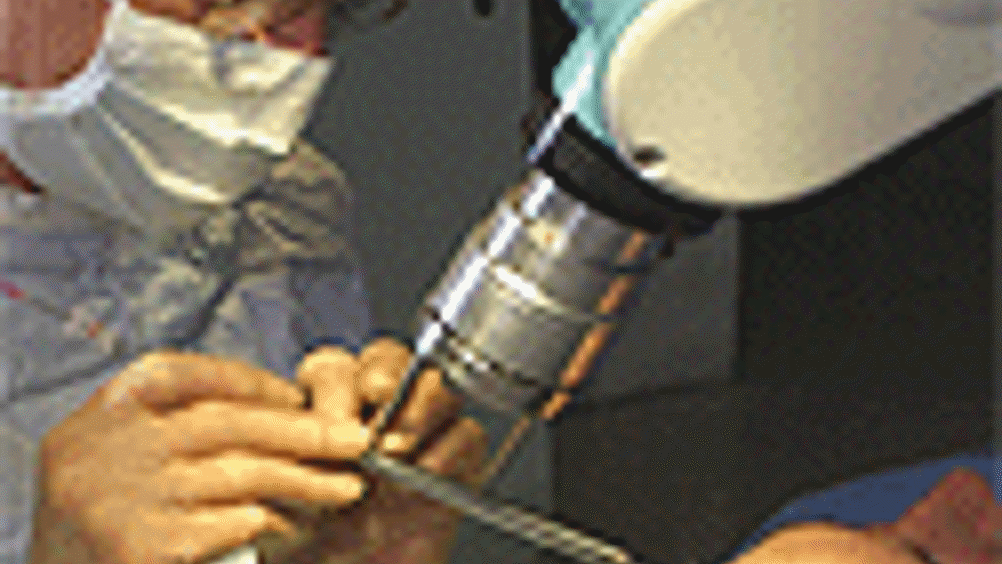Soothing a saw point

In the 19th century surgeons were known as 'sawbones' because that's exactly what they did — and they still do.
The tools have improved, some are even mechanised, but they are still utilitarian, with success and accurate procedures depending on the surgeon's manual dexterity and strength.
That could all change, with the introduction of high-power ultrasound. Low-power ultrasound of about one watt is commonly used for some medical imaging and treatments, but high power has, until now, been largely restricted to industrial processes. One researcher aims to bring it into the operating theatre.
Dr Andrea Cardoni lectures in ultrasonics at Glasgow University's mechanical engineering department. He helped Nestlé investigate the benefits of high power ultrasound for cutting chocolate.
Cutting the damage
'When you cut with a conventional blade, such as a saw or a knife, there is a lot of wastage,' said Cardoni. 'Material sticks to the blade and you can lose accuracy. The waste may also become stuck to other things.' He found that by applying vibrations from high-power ultrasound to the blade, the cut was cleaner and more accurate. So now he wants to apply the same advantages to surgery.
He has teamed up with Mectron Medical Technology of Genoa, Italy. The company recently launched an ultrasonic scalpel for upper jaw surgery that gives safe and precise cutting, even on highly mineralised bones. Cardoni believes ultrasound will cause less debris and damage to tissue and wants to develop the technology so it will become common in surgery.
'The main advantage of a vibrating knife is that you don't have to concentrate on applying the load to get through the tissue so you can concentrate on getting a more precise result,' said Cardoni. 'It becomes just a case of directing the knife.' It is similar to the difference between using a standard carving knife on the Sunday roast and using an electric knife. The latter can produce the thinnest slices.
He and Mectron are not the first to tackle the problem. In the 1960s, resonant vibrating scalpels were developed, with longitudinal vibrations of 50µ at 20-70Hz. One significant drawback was quickly discovered — simply holding the handle tended to burn the surgeon's hand. There were also energy losses because the blade tended to heat adjacent tissue. So the experiments were abandoned and surgeons went back to their chisels, saws and scalpels.
However, three decades later, an Italian surgeon, Tomaso Vercellotti saw that dentists were using ultrasound for dental scaling and eventually helped Mectron design its tool for upper jaw procedures. Meanwhile, Cardoni and colleagues were looking to develop a robotic arm which could have an ultrasonic device for orthopaedic operations.
'I found new techniques for the design of ultrasonic devices,' said Cardoni. 'I enhanced the design of the cutting tool and characterised the non-linearities. We were exciting the tool but that gave different modes of vibration from what we wanted. This non-linearity was known but we characterised it to find the explanation. So there was a major understanding of the behaviour and particularly of the non-linearity.'
This has allowed Cardoni to produce guidelines for designing high-power ultrasound components so they are not so prone to the non-linear behaviour. 'It means we can achieve precision with a scalpel,' he said. 'The next issue is that we don't want to cause burns.' The general rule is that tissue dies when heated to 50ºC.
'We investigated that by using a thermocouple with the cutting blade. It measured the temperature profile during a procedure and helped us to decrease it to less than 50ºC,' said Cardoni.
Exploiting non-linearity
Now Cardoni and Mectron are working together to develop cutting tools that are excited by high-power ultrasound. They are rated from 50W to 2kW, with a frequency of 20-150kHz. 'We want to design a new collection of tools for maxillo-facial operations and orthopaedic surgery,' said Cardoni. 'We want to improve the design and reduce the non-linear effects.'
By that he does not mean to eradicate the effects entirely. Instead, he suspects that they could be useful. 'I believe that certain non-linearities could be exploited,' he said. 'If we can channel and control them to create a complex vibration there could be advantages. By coupling, say, a bending mode with the cutting mode perhaps we could increase the speed of the operation.'
Cardoni's knowledge and laboratory experiments will be passed by Mectron to a network of surgeons in the US and Europe. The feedback they give will help him perfect a new generation of ultrasonic instruments for osteotomy and osteoplasty in implantology, periodontology, endodontics, orthodontic and orthopaedic surgery. Then surgeons will be able to leave their traditional chisels and saws at home in the toolbox.
Register now to continue reading
Thanks for visiting The Engineer. You’ve now reached your monthly limit of news stories. Register for free to unlock unlimited access to all of our news coverage, as well as premium content including opinion, in-depth features and special reports.
Benefits of registering
-
In-depth insights and coverage of key emerging trends
-
Unrestricted access to special reports throughout the year
-
Daily technology news delivered straight to your inbox










BEAS funding available to help businesses cut energy costs
And not a moment too soon, if the following exchange broadcast last Friday 13th June, on the Radio 4 ´Rare Earth´ program (link below, ~ 17 minutes...